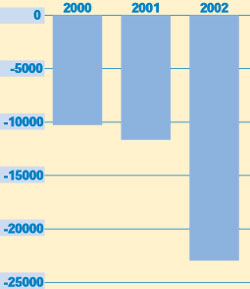 |
Rad-i-cal adj [from Latin radic-,
radix root] 1: marked by a considerable departure
from the usual or traditional 2: the proposition of
the United States Postal Service that everyone in America — no matter
who, no matter where — should receive the same high level of service at
the same affordable price.


We use two indicators to measure our efficiency. First,
we use Output per Workhour which measures the change in the relationship
between workload (mail volume and deliveries) and the labor resources
used to do the work. Second, we use Total Factor Productivity (TFP), which
measures the change in the relationship between workload, and all the
resources used in producing these outputs. Our main output is delivering
mail and service to an expanding delivery network. Resources measured
in the TFP calculations include labor for processing and delivery, transportation,
capital investments, materials and other non-personnel costs.
During 2002, our Output per Workhour grew by 2.2% and our TFP improved
by 1.1%. This TFP growth is equivalent to $700 million in expense reductions.
2002 marks our third consecutive year of positive TFP growth, with equivalent
expense reductions totaling over $3 billion over this time. Our productivity
growth continues to be fueled by substantial restraints on resource usage.
In 2002 we were able to achieve positive TFP growth as the volume of our
workload declined while deliveries grew, in contrast to the years before
2001 when our strong TFP growth was fueled largely by absorbing an ever-increasing
total workload.

Transportation expenses increased by $76 million in 2002. On August 27,
2001, we entered into a contract with FedEx to transport a portion of
expedited mail through their existing air network. After the terrorist
attacks on September 11, the Federal Aviation Administration placed restrictions
on mail pieces weighing more than 16 ounces, which prohibited the Postal
Service from using commercial air carriers to carry packages. We were
forced to move virtually all Priority Mail to either the FedEx network
or our surface network, with a small volume of mail on air taxis, which
is costly. Although the FedEx network is less expensive than our old dedicated
network, it is more expensive than commercial air carriers. The increased
use of the FedEx network has increased air transportation costs. We are
currently moving 51% of Priority Mail on our surface network, 48% on FedEx
and 1% on contracted off-shore air taxis to service routes not served
by FedEx.
Even with the additional increase in volume to the FedEx network, we were
able to keep the growth in transportation costs to a minimum. We moved
more Priority Mail to surface transportation, reducing those network costs.
We renegotiated our existing contract with FedEX to lower rates as volume
on that network increased. A decrease in mail volume and a decline in
fuel prices also helped us control our transportation costs.
We think that our transportation costs for 2003 will remain in line with
our costs for 2002. We continue to work with the Transportation Safety
Administration with the expectation that we will again be able to use
passenger air transportation for Priority Mail. We are also working to
integrate and realign our distribution and transportation infrastructure.


|
 |


IN THE LAST THREE YEARS,
WE
REDUCED OUR WORKFORCE
EVEN AS WE ADDED 5.4 MILLION
DELIVERY POINTS

 |
 |
 |
|
2002
|
2001
|
2000
|
 |
 |
 |
|
1.5%
|
7.4%
|
10.4%
|
 |
 |
 |
|
|






